Italy, China, and the Coronavirus
Gregory Hood, American Renaissance, April 23, 2020
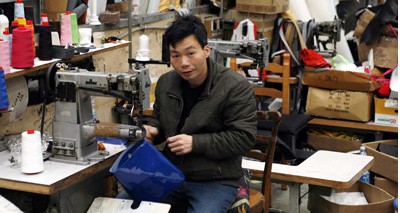
For decades, a large, sometimes hostile Chinese community has worked in the Italian fashion and textile industries. Immigrants — legal and illegal — started as a cheap, “exploited” labor source that allowed high-fashion companies to slap a “Made in Italy” label on products churned out in sweatshops. Now, Chinese own many off-the-books factories, ignoring employment and safety laws, and dodging taxes. They are also carving out a competitive niche in the fashion industry, and even buying up iconic Italian companies.
Was the China connection the reason the coronavirus outbreak hit Italy so hard and so early? So much immigration has been illegal — and so many Chinese factories don’t even exist on paper — that contact tracing and other disease control measures were impossible.
Where did the Chinese come from? How many are there?
The first Chinese migrants settled in Milan and Turin in the 1930s, with a few more trickling in over the next decades. Many were peddlers, and some opened family workshops for leather goods. In 1975, there were only 402 Chinese adults in the country,[1] but more arrived during the early 1980s. Like earlier migrants, they came mostly from Zhejang Province in southeast China, especially the coastal city of Wenzhou.[2]
In 1986, Italy granted 1,618 residency permits to Chinese. In 1996, it granted 16,200, and in 2001, the figure was almost 69,000.[3] The number of illegals was unknown. In 1986, 1990, 1995, 1998, and 2002, Italy passed a series of amnesties and “reforms,” and every one of them encouraged immigration.[4] For example, in 1995, the government let illegals stay in the country if they registered with police. In 1998, a liberal government passed a law that let any public entity (including immigrant advocacy groups and NGOs) sponsor migrants.[5] Immigrants got access to the medical system[6] and can now bring in relatives through “family reunification schemes.”
There were supposed to be measures to stop employers from exploiting immigrant laborer or smuggling in workers,[7] but as in America, employer sanctions were rarely enforced. In 2002, a “tougher” immigration law passed by the Silvio Berlusconi’s conservative government still also included amnesty for some illegals.
According to the Italian government, there were 69,620 Chinese “resident foreigners” in 2003. Just 16 years later in 2019, that figure was 299,823, not counting illegals or Chinese who had taken Italian citizenship. This figure increased every year, except for a small decline from 2011 to 2012 during a brief local crackdown on illegal Chinese businesses.[8] As in America, employers want more workers. According to a survey from the Italian equivalent of the Chamber of Commerce, Italian companies would have been happy to take at least 100,000 new immigrants in 2001 alone.[9]
Many people think the government undercounts Chinese. A 2017 report said there were 318,975 legal Chinese residents, and a quarter were children. For comparison’s sake, there were reportedly 136,460 Chinese in Germany in 2019 — not even half the number in Italy — in a country of 83 million compared to Italy’s 60 million.
Many Chinese came to Italy opportunistically. The University of Bologna’s Antonella Ceccagno says Chinese look at Europe as a “chess board on which various family members move around.” They are in touch with Chinese already living in Europe, and look for a place where they can be “legalized.”[10] Many may have sneaked into Italy expecting future amnesties.
A large number settled in Prato, a city of 200,000 not far from Florence. Prato has long been the center of the Italian textile/clothing industry, and Chinese used kinship networks to build small, independent businesses[11] producing clothes under contract for major brands.[12] World-renowned companies sold cheaply made high-end goods that were “Made in Italy” but by Chinese sweatshop labor. Ironically, China is the number one market for brands such as Prada, Giorgio Armani, Fendi, Bottega Veneta, Salvatore Ferragamo.
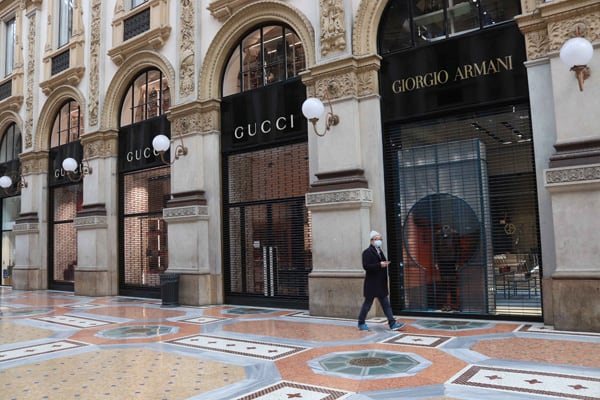
(Credit Image: © Italy Photo Press via ZUMA Press)
The Chinese branched out from contract work and started independently producing pronto moda, “fast fashion,” trendy clothes for low-end retailers.[13] Chinese used cheap fabric to make knock-offs of top brands in small batches but very quickly.[14] Low-income consumers could enjoy cheap versions of high fashion. Chinese owners quickly became expert at setting up shell companies, flouting labor and health laws, using unsafe equipment, and dodging taxes.
The “Italian” fashion industry
It’s hard to count the Chinese in Italy because so many have entered illegally and so many work off the books. In 2018, the US State Department reported that “Chinese victims [of human trafficking] work in textile factories in Milan, Prato, Rome, and Naples.”[15] KnowTheChain says Prada, Fendi, and other brands often use “exploited labor.” The big companies plead ignorance; they use subcontractors that can shut down, reorganize, and reopen before police even know they’re there. Thus, an Italian luxury brand that boasts “Made in Italy” could be using Chinese-run subcontractors that don’t even exist on paper.
In 2008, the Chicago Tribune reported that “Chinese immigrants transform Italy’s fashion industry,” and that Prato is now a place “where two cultures can live side by side and never really know each other.” According to the paper, there were 30,000 legal immigrants and an equal number of illegals in a city where “social integration is almost non-existent.” The article concluded that “Chinese workers keep ‘Made in Italy’ fashion afloat.”
Likewise in 2008, a Los Angeles Times articles called “Slaving in the lap of luxury” asking readers to imagine “Chinese immigrants toiling long hours in ramshackle, poorly illuminated sheds” so companies could “quadruple a price” by claiming the goods were “Made in Italy.” It also reported that Chinese were “probably close to 25 percent [of the population of Prato] when illegal Chinese are counted.”
In 2010, the New York Times reported that “Prato’s streets have slowly become more and more Chinese,” as “Chinese have bought out Italian-owned shops and apartments often paying in cash.” The number of Chinese-owned businesses in Prato grew 35 percent from 2008 to 2013, while the number of Italian companies shrank. Chinese born in Italy were going back to school in China “to keep their options open.”
In December 2013, Reuters estimated that 50,000 Chinese lived in the Prato area, two-thirds of them illegal, and that the city council thought 90 percent of Chinese factories broke the law. Many people thought Prato was “a thriving hub of illegality committed by both Italians and Chinese, a byproduct of globalization gone wrong.” It was common to suspect that the local government overlooked sweatshop work because it was good for the economy. Parts of Prato became increasingly alien: streets lined with massage parlors, slot machines, and Chinese graffiti offering jobs, shared rooms, and paid female companionship.
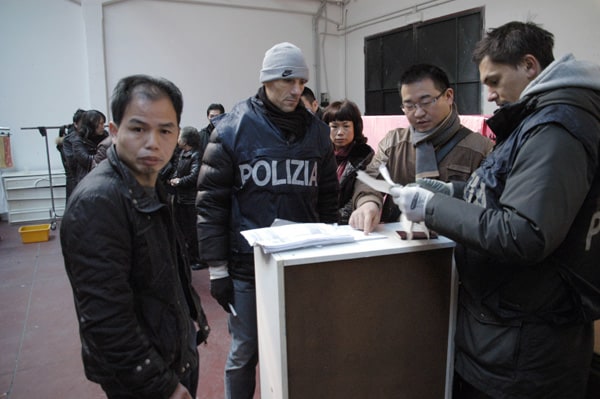
Prato – Police raid hundreds of Chinese clothing factories to find illegal workers. Many undocumented workers were arrested. (Credit Image: © Giovanni Attalmi/ROPI via ZUMA Press)
In October 2014, the Associated Press wrote about the “thriving, illicit Chinese economy” of Prato, where immigrants worked 12- to 14-hour days, were paid two or three Euros an hour (far below minimum wage) and slept at the factory (in violation of Italian law). The AP found that Chinese-owned factories “replicated the habits of home.” “Merchandise isn’t exported,” concluded the article, “China itself is.” No need to contract out to cheap-labor countries when cheap-labor countries can come to you. And Chinese send their money home: Remittances from Italy are more than $1 billion a year.[16]
Tensions and rioting
Chinese aren’t assimilating. In 2007, 300 Chinese — waving a Chinese flag — rioted after a Chinese woman got into an argument with Italian traffic wardens. A 2013 documentary about Chinese-Italian friction includes footage of the riot, which was the first known Chinese riot in all of Europe.
In 2016, Chinese rioted again, throwing rocks and bottles at riot police sent to disperse them. They were protesting against health and regulations checks at a factory.
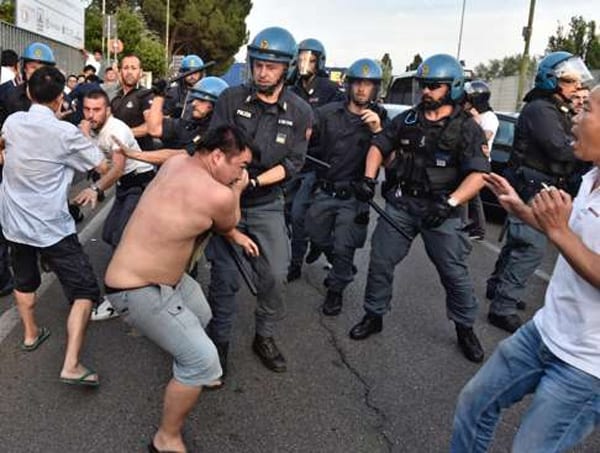
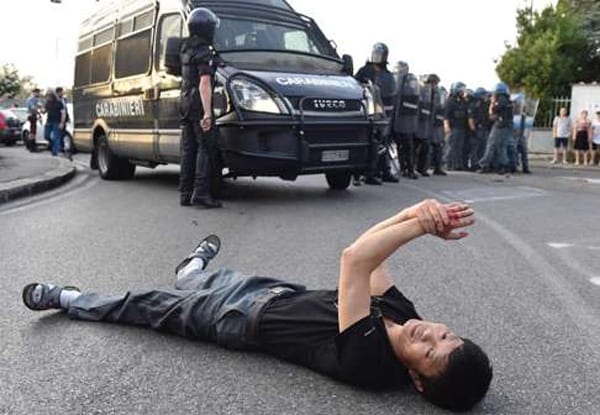
Police also cracked down on a Chinese organization in Prato called “White Stag” that runs prostitutes and drugs, and beats up Moroccans and other North Africans — with whom Chinese do not get along. In 2018, Prato police estimated that 85 percent of Chinese-owned factories paid protection money to Chinese gangsters.
In 2017, the Milan branch of the Bank of China was caught laundering $5 billion, mostly undeclared income from Chinese-run businesses and profits from counterfeit high fashion goods. The bank paid a $20 million fine.
Likewise, in 2017, 600 Chinese illegal immigrants rioted in Prato, waving a banner reading “This is China, Not Italy.” Police had to use tear gas to break up the mob. Again, the complaint was factory inspections. Between 2014 and 2017, Prato authorities conducted 8,000 surprise inspections, almost always finding serious infractions.
In 2018, The Economist cheerfully brushed all this aside, arguing that Italians should be grateful:
The arrival of Chinese factory owners and their workers has saved Prato from the fate of some places in the rich world that suffered badly as a result of competition from developing economies like China’s.
In other words, sweatshop drudges “saved” Italians from the Chinese.
Increasing Chinese power
While Chinese immigrants build small companies, Chinese in China are buying big Italian companies. In 2013, the Epoch Times reported that China now owns several iconic companies, such as Cerruti, Fioruccui Foods, and Desmo. In addition to the official 2017 count of no fewer than 50,737 Chinese-owned local businesses, by 2014, Chinese interests owned some 200 Italian businesses, and China’s central bank held stakes in Italian blue chips such as Fiat, Telecom Italia, Generali, and Eni.
State-to-state economic cooperation is growing. Italy was the first European country to sign up with China’s “Silk Road” plan, which will spend almost $3 billion on transportation infrastructure connecting the two countries.
Chinese tourists pour into Italy; about three million visited in 2016. They come in such throngs that China sends its own police officers to conduct joint patrols with Italian police in Rome, Milan, Florence, Naples, Turin, and Padua. Chinese now run a special Chinese-language hotline in Italy. This year was supposed to be the “China-Italy year of culture and tourism,” but the virus quashed that plan.
The Coronavirus connection?
With these close connections, there is plenty of business and personal travel between Italy and China. It was inevitable that people would wonder whether Chinese smuggled into the country and working in cramped sweatshops could have introduced and spread the virus. At this point, with lax immigration law enforcement and spotty travel records, it’s impossible to know.
We do know that the first confirmed cases in Italy were Chinese tourists from Wuhan, but Wuhan is more than 500 miles from Wenzhou, which is where most of the Prato Chinese come from. The virus did hit Wenzhou, though, and many Chinese in Italy had gone home for the Lunar New Year, which was January 25. By the 29th, there were 172 cases in the province. It may be that Chinese returning to Italy after the holiday brought the disease with them — but this can’t be proven.
On January 31, Italy stopped direct flights from China, which the Chinese government called an “overreaction,” but by then, tourists or returning workers could have already brought the disease to Italy.
That said, one of the very first covid patients in Italy was an Italian who has never traveled to China. He went to the emergency room on February 19, but it was 36 hours before he was tested. He probably infected a number of people, including his father (who died from the disease) and his pregnant wife (who didn’t).
Also, Prato, has a very low infection rate. If test reports can be believed, not one Chinese has the disease. It certainly does not appear that Prato is a hotbed — and there may be an interesting reason for this. According to Reuters, Chinese who had returned to the city from New Year celebrations knew very well that a dangerous virus was spreading in China. Chinese therefore put their community into lockdown three weeks before Italy recorded its first infection. According to Reuters, “They knew what was coming and spread the word: stay home.” There is “some anecdotal evidence that Chinese people in [other parts of] Italy did the same.”
This suggests that the Chinese acted independently and thought only of themselves. It also means the Italian government has no idea what is going on in the community. Dr. Giorgio Palu, a virologist and former health official, said the Italian government acted too slowly because it was afraid of being called “racist.” But if the Reuters report is accurate, in early February, just when the mayor of Florence was telling citizens to “Hug a Chinese” to fight stigma and racism, the Chinese were already keeping their distance from each other.
Northern Italian fashion defines luxury, wealth, and status — but it’s built on a Chinese colony and off-the-books labor. The coronavirus outbreak reminds us that Sam Francis was right: Anarcho-tyranny is the ultimate stage of multiculturalism. Italy imposed draconian rules on its own people to stop the spread of coronavirus. At the same time, it doesn’t know how many Chinese are in the country, where they are from, where they work, or when they come and go.

Prato – Chinese working in a clothing factory. (Credit Image: © Giovanni Attalmi/ROPI via ZUMA Press)
Aside from whether they had any role in the outbreak, Chinese have built a parallel, sometimes hostile society in Italy, and many clearly think of themselves as exclusively Chinese. Italy is just a place to make money. At the same time, Chinese are shoving out low-level Italian competitors and even beginning to take holdings in top firms. It’s a high price to pay for extra profits on “luxury items” churned out by coolies in Prato sweatshops.
* * *
[1] “Chinese descendants in Italy: emergence, role, and uncertain identity” by Anna Marsden, published in Belonging to the Nation: Generational Change, Identity, and the Chinese Diaspora, edited by Edmund Terence Gomez and Gregor Benton, Routledge, 2014, p. 83.
[2] “New Chinese Migrants in Italy,” by Antonella Ceccagno, International Migration, Volume 41 (3), Blackwell Publishing Ltd 2003, p. 187
[3] “New Chinese Migrants in Italy,” by Antonella Ceccagno, International Migration, Volume 41 (3), Blackwell Publishing Ltd 2003, p. 196
[4] “New Chinese Migrants in Italy,” by Antonella Ceccagno, International Migration, Volume 41 (3), Blackwell Publishing Ltd 2003, p. 190.
[5] Immigrants at the Margins: Law, Race, and Exclusion in Southern Europe, by Kitty Calavita, Cambridge University Press, 2005, p. 32
[6] “Italy: Immigraiton, Economic Flexibility, and Integration,” by Kitty Calavita, University of California, Irvine, February 2006, p.
[7] Immigrants at the Margins: Law, Race, and Exclusion in Southern Europe, by Kitty Calavita, Cambridge University Press, 2005, p. 31
[8] “The Hidden Crisis: The Prato Industrial District and the Once Thriving Chinese Garment Industry,” by Antonella Ceccagno, Revue Europeenne des Migrations Internationales, Volume 28, 2012, p. 52
[9] “New Chinese Migrants in Italy,” by Antonella Ceccagno, International Migration, Volume 41 (3), Blackwell Publishing Ltd 2003, p. 192
[10] “New Chinese Migrants in Italy,” by Antonella Ceccagno, International Migration, Volume 41 (3), Blackwell Publishing Ltd 2003, p. 195
[11] City Making & Global Labor Regimes: Chinese Immigrants and Italy’s Fast Fashion Industry, by Antonella Ceccagno, Palgrave Macmillan, 2017, p. 71
[12] Ibid.
[13] “The Chinese Workers Who Assemble Designer Bags in Tuscany,” by D.T. Max, The New Yorker, April 9, 2018.
[14] City Making and Global Labor Regimes: Chinese Immigrants and Italy’s Fast Fashion Industry, by Antonella Ceccagno, Palgrave Macmillan, 2017, p. 132.
[15] “Trafficking in Persons Report, June 2018” United States Department of State, P. 242
[16] “The Chinese Diaspora: Historical Legacies and Contemporary Trends,” by Daniel Goodkind, United States Census Breau, August 2019, p. 34















